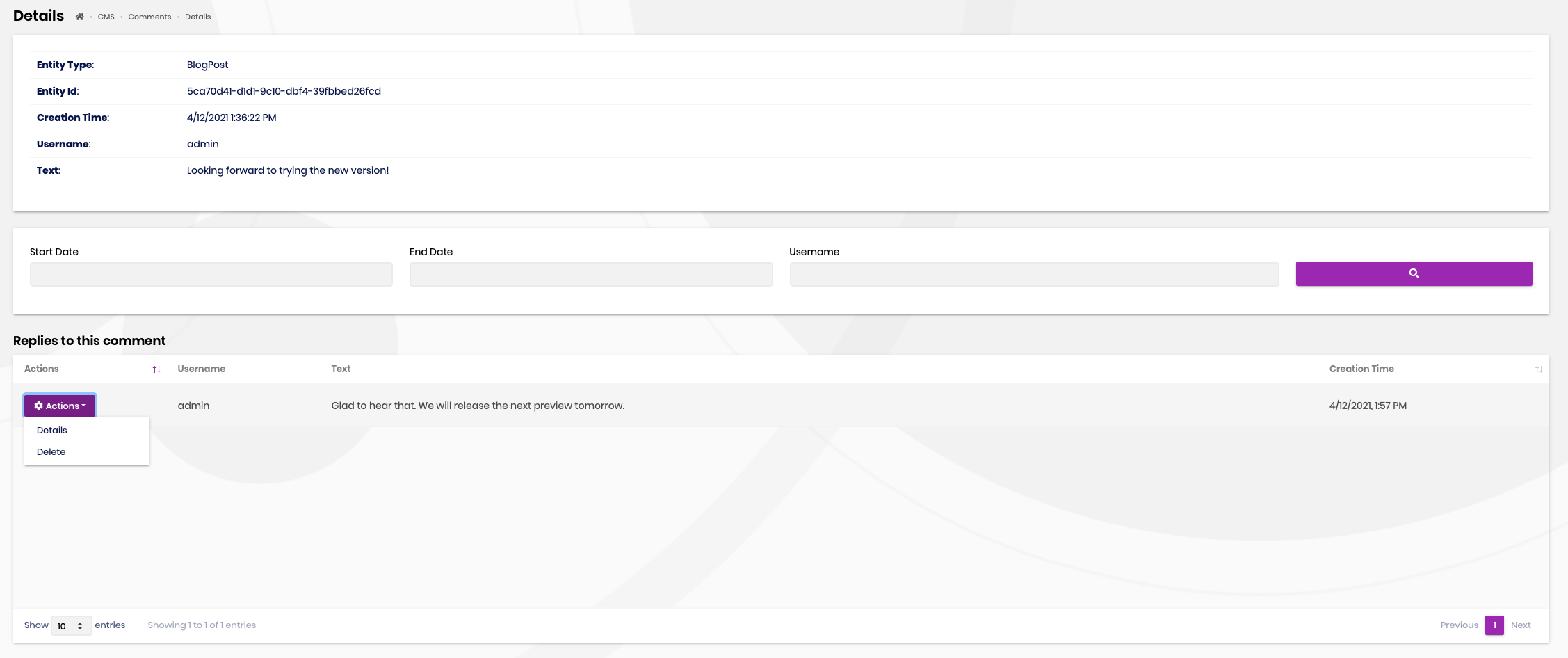CMS Kit: Comments
CMS Kit provides a comment system to add the comment feature to any kind of resource, like blog posts, products, etc.
Enabling the Comment Feature
By default, CMS Kit features are disabled. Therefore, you need to enable the features you want, before starting to use it. You can use the Global Feature system to enable/disable CMS Kit features on development time. Alternatively, you can use the ABP's Feature System to disable a CMS Kit feature on runtime.
Check the "How to Install" section of the CMS Kit Module documentation to see how to enable/disable CMS Kit features on development time.
Options
The comment system provides a mechanism to group comment definitions by entity types. For example, if you want to use the comment system for blog posts and products, you need to define two entity types named BlogPosts and Product, and add comments under these entity types.
CmsKitCommentOptions can be configured in the domain layer, in the ConfigureServices method of your module. Example:
Configure<CmsKitCommentOptions>(options =>
{
options.EntityTypes.Add(new CommentEntityTypeDefinition("Product"));
options.IsRecaptchaEnabled = true; //false by default
options.AllowedExternalUrls = new Dictionary<string, List<string>>
{
{
"Product",
new List<string>
{
"https://abp.io/"
}
}
};
});
If you're using the Blogging Feature, the ABP defines an entity type for the blog feature automatically. You can easily override or remove the predefined entity types in
Configuremethod like shown above.
CmsKitCommentOptions properties:
EntityTypes: List of defined entity types(CmsKitCommentOptions) in the comment system.IsRecaptchaEnabled: This flag enables or disables the reCaptcha for the comment system. You can set it as true if you want to use reCaptcha in your comment system.AllowedExternalUrls: Indicates the allowed external URLs by entity types, which can be included in a comment. If it's specified for a certain entity type, then only the specified external URLs are allowed in the comments.
CommentEntityTypeDefinition properties:
EntityType: Name of the entity type.
The Comments Widget
The comment system provides a commenting widget to allow users to send comments to resources on public websites. You can simply place the widget on a page like below.
@await Component.InvokeAsync(typeof(CommentingViewComponent), new
{
entityType = "Product",
entityId = "...",
isReadOnly = false,
referralLinks = new [] {"nofollow"}
})
entityType was explained in the previous section. entityId should be the unique id of the product, in this example. If you have a Product entity, you can use its Id here. referralLinks is an optional parameter. You can use this parameter to add values (such as "nofollow", "noreferrer", or any other values) to the rel attributes of links.
User Interface
Menu Items
The following menu items are added by the commenting feature to the admin application:
- Comments: Opens the comment management page.
Pages
Comment Management
You can view and manage comments on this page.

You can also view and manage replies on this page.

Settings
You can configure the approval status of comments using the "Comment" tab under the "Cms" section on the Settings page. When this feature is enabled, you can approve and reject comments. In this way, users can only see the comments that you approve. By default, this feature is set to "false."

Internals
Domain Layer
Aggregates
This module follows the Entity Best Practices & Conventions guide.
Comment
A comment represents a written comment from a user.
Comment(aggregate root): Represents a written comment in the system.
Repositories
This module follows the Repository Best Practices & Conventions guide.
The following custom repositories are defined for this feature:
ICommentRepository
Domain services
This module follows the Domain Services Best Practices & Conventions guide.
Comment Manager
CommentManager is used to perform some operations for the Comment aggregate root.
Application layer
Application services
CommentAdminAppService(implementsICommentAdminAppService): Implements the use cases of the comment management system, like listing or removing comments etc.CommentPublicAppService(implementsICommentPublicAppService): Implements the use cases of the comment management on the public websites, like listing comments, adding comments etc.
Database providers
Common
Table / collection prefix & schema
All tables/collections use the Cms prefix by default. Set static properties on the CmsKitDbProperties class if you need to change the table prefix or set a schema name (if supported by your database provider).
Connection string
This module uses CmsKit for the connection string name. If you don't define a connection string with this name, it fallbacks to the Default connection string.
See the connection strings documentation for details.
Entity Framework Core
Tables
- CmsComments
MongoDB
Collections
- CmsComments


























































